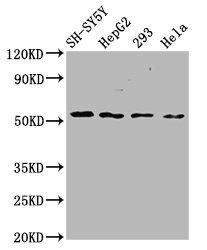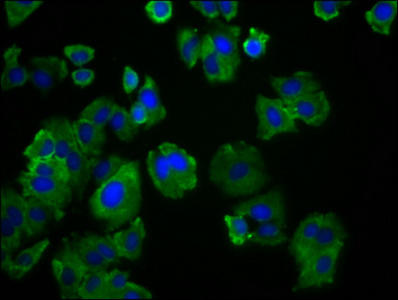Description
| Antibody Name: | SLC19A3 Antibody (PACO59377) |
| Antibody SKU: | PACO59377 |
| Size: | 50ug |
| Host Species: | Rabbit |
| Tested Applications: | ELISA, WB, IF |
| Recommended Dilutions: | ELISA:1:2000-1:10000, WB:1:500-1:5000, IF:1:50-1:200 |
| Species Reactivity: | Human |
| Immunogen: | Recombinant Human Thiamine transporter 2 protein (191-282AA) |
| Form: | Liquid |
| Storage Buffer: | Preservative: 0.03% Proclin 300 Constituents: 50% Glycerol, 0.01M PBS, pH 7.4 |
| Purification Method: | >95%, Protein G purified |
| Clonality: | Polyclonal |
| Isotype: | IgG |
| Conjugate: | Non-conjugated |
 | Western Blot. Positive WB detected in: SH-SY5Y whole cell lysate, HepG2 whole cell lysate, 293 whole cell lysate, Hela whole cell lysate. All lanes: SLC19A3 antibody at 3.6µg/ml. Secondary. Goat polyclonal to rabbit IgG at 1/50000 dilution. Predicted band size: 56 kDa. Observed band size: 56 kDa. |
 | Immunofluorescence staining of HepG2 cells with PACO59377 at 1:166, counter-stained with DAPI. The cells were fixed in 4% formaldehyde, permeabilized using 0.2% Triton X-100 and blocked in 10% normal Goat Serum. The cells were then incubated with the antibody overnight at 4°C. The secondary antibody was Alexa Fluor 488-congugated AffiniPure Goat Anti-Rabbit IgG(H+L). |
| Background: | Mediates high affinity thiamine uptake, probably via a proton anti-port mechanism. Has no folate transport activity. |
| Synonyms: | Thiamine transporter 2 (ThTr-2) (ThTr2) (Solute carrier family 19 member 3), SLC19A3 |
| UniProt Protein Function: | Mediates high affinity thiamine uptake, probably via a proton anti-port mechanism. Has no folate transport activity. |
| NCBI Summary: | This gene encodes a ubiquitously expressed transmembrane thiamine transporter that lacks folate transport activity. Mutations in this gene cause biotin-responsive basal ganglia disease (BBGD); a recessive disorder manifested in childhood that progresses to chronic encephalopathy, dystonia, quadriparesis, and death if untreated. Patients with BBGD have bilateral necrosis in the head of the caudate nucleus and in the putamen. Administration of high doses of biotin in the early progression of the disorder eliminates pathological symptoms while delayed treatment results in residual paraparesis, mild cognitive disability, or dystonia. Administration of thiamine is ineffective in the treatment of this disorder. Experiments have failed to show that this protein can transport biotin. Mutations in this gene also cause a Wernicke's-like encephalopathy.[provided by RefSeq, Jan 2010] |
| UniProt Code: | Q9BZV2 |
| NCBI GenInfo Identifier: | 13376856 |
| NCBI Gene ID: | 80704 |
| NCBI Accession: | NP_079519.1 |
| UniProt Related Accession: | Q9BZV2 |
| Molecular Weight: | 55,665 Da |
| NCBI Full Name: | thiamine transporter 2 |
| NCBI Synonym Full Names: | solute carrier family 19 member 3 |
| NCBI Official Symbol: | SLC19A3 |
| NCBI Official Synonym Symbols: | BBGD; THMD2; THTR2 |
| NCBI Protein Information: | thiamine transporter 2 |
| UniProt Protein Name: | Thiamine transporter 2 |
| UniProt Synonym Protein Names: | Solute carrier family 19 member 3 |
| Protein Family: | Thiamine transporter |
| UniProt Gene Name: | SLC19A3 |
| Antibodies |
| SLC19A3 Antibody (PACO12246) |
| Secondary Antibody |
| Anti-HRP Goat Anti-Rabbit IgG (H+L) Antibody (CABS014) |
| Recommended Products |
| Anti-FITC Goat Anti-Rabbit IgG (H+L) Antibody (CABS011) |
| Anti-HRP-conjugated Beta Actin Antibody (CABC028) |






